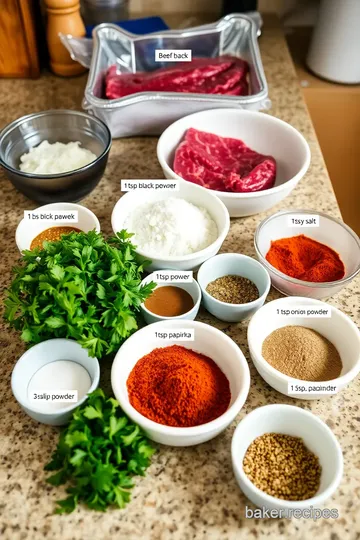Homemade Beef Salami
Elevate your charcuterie board with our slow-cooked beef salami recipe. Follow Baker Recipes for step-by-step instructions to craft a tender, flavorful salami perfect for gourmet gatherings and home cooking delight.

- The Magic Behind This Recipe
- Health & Nutrition Highlights
- Recipe at a Glance
- Quality Ingredients Breakdown
- Kitchen Equipment Essentials
- Professional Cooking Guide for Homemade Beef Salami
- Master Chef's Advice
- Perfect Presentation
- Storage & Make-Ahead
- Creative Variations
- Expert FAQ Solutions
- Complete Nutrition Guide
- Recipe Card
Ah, beef salami! Can we just take a moment to appreciate this savory delight? It’s not just about enjoying slices tossed on a charcuterie board or wedged between two slices of bread. The story of homemade beef salami is deeply rooted in historical traditions that go back centuries. Cured meats like salami date back to ancient Roman times, where preservation techniques were developed to ensure food lasted longer. Fast forward to today, this culinary marvel reveals the craftsmanship of artisanal meat preparers who elevate simple ingredients into a tantalizing culinary experience.
What sets this recipe apart is its ability to combine the richness of tradition with modern-day convenience. Making homemade beef salami is not just about crafting a delicious meat treat; it’s also about control. Control over flavors, the process, and, of course, knowing exactly what goes into your food. Curious about health? This recipe incorporates real beef without those vague ingredients found in many store-bought options. Plus, the satisfaction of knowing you created it yourself can’t be beaten.
Homemade Beef Salami: A Culinary Journey
When you prepare homemade beef salami, you’re not just engaging in a cooking project; you’re diving deep into a rich culinary heritage. Salami, specifically, is celebrated worldwide, adopting various local flavors and techniques. Its origins hark back to a time when food preservation was a necessity. Each bite is not only filled with flavor, but it also carries pieces of history and culture, representing the regions from which it hails. The cultural significance is immense, often featured in festive gatherings and as a staple in many kitchens across the globe.
Today, homemade beef salami has gained modern-day popularity among food enthusiasts and amateur chefs alike. It's a delicious dish that is rapidly becoming a cherished kitchen project. You really feel a rush of accomplishment as you hang your freshly stuffed sausage, waiting for it to cure!
The Magic Behind This Recipe
Now let’s chat about what makes this beef salami so magical—it's all in the flavor combinations! You’ve got the robust notes of garlic and paprika that dance upon the palate, mingling with the earthiness of black pepper and coriander. It’s pure bliss. The technique might seem daunting at first, but don’t worry; with a few expert-tested methods, it becomes a breeze. Trust me, the first time I tried it, I overstuffed a casing and, uh, had a bit of a mini-explosion. But hey, I learned to stuff it just right!
You'll also find some time-saving tips sprinkled here and there, especially when it comes to the curing process. Honestly, I’ve crafted my routine to make it easier; I set reminders for flipping the sausages while binge-watching my favorite show! And let's not forget about the option to smoke it for that extra depth of flavor—because who doesn't love smoky goodness?
Health & Nutrition Highlights
Are you ready for some good news? Homemade beef salami is packed with some serious nutritional benefits. Rich in protein, that's like a high-five to your muscle health! Each serving is not just satisfying but also contributes to your overall wellness with essential minerals and vitamins. Sure, it has a bit of fat, but that’s what makes it flavorful and filling.
Dietary considerations are important too. Whether you’re following a low-carb diet or simply want to enjoy a treat that ticks off nutritional boxes, this beef salami does just that. Remember my friend who was trying to eat cleaner? This was a game-changer for him—just make it in moderation, and you’re golden!
Recipe at a Glance
So, let's talk logistics for a moment. This homemade beef salami requires around 30 minutes of hands-on preparation, but patiently, we’re looking at a total time commitment of about 8 hours and 30 minutes once you factor in the curing! It’s a bit of a waiting game, but definitely worth it. Oh, and don’t let the "medium" difficulty scare you off; trust me, you'll be a salami wizard in no time.
Planning for a gathering? This recipe makes around 10 servings, so it’s perfect for sharing. And if you're worried about costs, it's surprisingly economical given that store-bought options can sometimes break the bank. Plus, think of it this way—you'll impress friends with your charcuterie skills without spending a fortune.
Homemade beef salami is a delightful culinary adventure waiting for you. There’s something so satisfying about crafting it in your own kitchen, embracing both tradition and creative flair. So, what are you waiting for? Dive into making your own beef salami and join a rich lineage of culinary history!

Quality Ingredients Breakdown
Premium Core Ingredients
When making beef salami , the foundation is all about choosing high-quality ingredients. For this recipe, you'll need 3 lbs of beef chuck steak . Look for beef that is bright red with minimal fat—trust me, trimming that excess fat will result in a better texture. If you're unsure about what looks good, ask your butcher for help; they usually have the freshest cuts and can give you pointers on what to choose!
Also, don’t forget about storage. Keep your beef in the coldest part of your fridge, and plan to use it within a few days if it’s fresh. If you’ve bought it in bulk, consider freezing some. Just make sure to wrap it well to prevent freezer burn.
Signature Seasoning Blend
Now, onto the seasoning blend that adds that magical flavor to your salami. In total, you’ll use about 1 tbsp of kosher salt, 1 tsp of black pepper, and other delightful spices like paprika and ground coriander . My personal favorite is the 1/4 tsp of crushed red pepper flakes , which gives it a bit of a kick. You can always adjust these spices based on your preference (more heat? Go for extra red pepper flakes!).
When you pick out these herbs and spices, freshness is key. I recommend checking the expiration dates and opting for whole spices if you can. They pack a ton of flavor when freshly ground. For storage, keep all your spices in a cool, dark place—trust me, it makes a world of difference in taste!
Smart Substitutions
If you find yourself missing an ingredient, don’t sweat it! For instance, if you’re out of red wine, you can use apple cider vinegar or even beef broth in a pinch. And for those watching sodium intake, you can replace kosher salt with a sodium-free alternative.
Have dietary restrictions? Swap the non-fat dry milk powder with almond milk powder for lactose-free salami. The beauty of this recipe is that it’s super flexible—so embrace those summer flavors by using fresh herbs in place of dried ones if you’re lucky enough to have a garden!
Kitchen Equipment Essentials
Making beef salami at home requires the right tools. First and foremost, you’ll need a meat grinder ; it’s a game-changer! Plus, a sausage stuffer is essential for filling your casings. I’ve tried stuffing without one, and let me tell you, it was a disaster of epic proportions—never again!
If you don’t have a meat grinder, don’t panic! You can use a food processor, but pulse the meat instead of grinding it. And honestly, can we talk about the importance of a good instant-read thermometer ? It’s honestly worth its weight in gold when measuring internal temperatures.
Pro Ingredient Tips
Alright, let’s get into some nitty-gritty secrets that I've picked up over the years. Always choose cuts of beef from the round or chuck—these are well-marbled and provide a great texture. As for the spices, look for whole options that you can grind yourself. It’s like the difference between fresh coffee beans and instant coffee. Trust me; it’s a revelation!
When it comes to storage, I recommend vacuum-sealing your finished salami. It extends shelf life significantly! And if you’re balling on a budget, remember that buying spices in bulk can save you a heap of cash in the long run. Just don’t let them sit unused in your pantry. A little knowledge goes a long way.
Now, go ahead, and get your hands dirty making your very own beef salami! It's a labor of love that you'll treasure every time you bite into those savory slices. The satisfaction of creating something from scratch is truly unmatched, and you’ll be the life of any party showcasing your tasty creation! Happy salami-making!
Professional Cooking Guide for Homemade Beef Salami
Cooking homemade beef salami is an enjoyable, hands-on process that rewards you with incredible flavor. You’ll feel like a culinary rockstar when you serve it up. Here’s how to whip up your very own salami, step-by-step.
Essential Preparation Steps
Mise en Place Details
The secret to any great cooking session is getting your ingredients and tools ready. Start by gathering everything you need: beef chuck, spices, casing, a grinder, a stuffer, and a curing setup. This makes the process smooth and efficient. Trust me, it’s way less chaotic!
Prep Techniques
Begin by trimming the beef. Aim for small chunks (about 1-2 inches) and don’t skip on removing excess fat. I’ve learned the hard way that fat leads to a grainy texture. Use a meat grinder fitted with a medium plate to get the right grind; this will enhance the salami’s mouthfeel.
Time Management
Set aside 30 minutes for prep and about 8 hours for curing and possibly smoking. Plan for at least a week of waiting as it cures. Yep, patience is key!
Organization Tips
Keep your workspace neat. A clutter-free kitchen keeps you focused. Plus, it saves you from fishing through a mountain of mess to find your stuffer—believe me, you don’t want that.
Professional Cooking Method
Step-by-Step Process
- Soak your casings in lukewarm water for 30 minutes. Rinse them well to get rid of that salty residue.
- Trim and grind your beef, then mix in seasonings and other ingredients. This mixture should feel tacky. It’s a good sign; it means you’re on the right track!
Temperature Control
For curing, aim for a temperature around 60-70°F with low humidity. I always double-check with a thermometer because this can be a game-changer. Your salami will only be as good as your environment!
Timing Precision
Curing takes about 5-7 days, but don’t rush it. The flavor will deepen each day. If smoking, do this at 160°F until your internal temp hits 155°F. An instant-read thermometer will be your best friend here.
Success Indicators
Look for that firm exterior and a rich, developed aroma once it’s cured. You want it to feel dry but still have a slight give. If it’s too mushy, you might need to slow down and adjust your technique for next time.
Expert Techniques
Professional Methods
When stuffing the casings, be aware of air pockets. Air can ruin your salami! Prick the sausages with a pin afterwards to release any trapped air. Don’t skip this—trust me; I’ve made that mistake!
Critical Steps
Always check your pH level if you can. Aim for around 5.3 to 5.6; this ensures safety. I once ignored this step, and, well, let’s say I learned my lesson!
Precision Points
Use a meat thermometer throughout the process. This guarantees safety and quality, ensuring the best possible beef salami.
Quality Checks
Keep an eye on the texture when slicing. It should feel a bit firm, like a quality deli slice. If it's too soft, something might have gone wrong in your process.
Success Strategies
Troubleshooting Tips
If your salami shrinks too much, it could be a sign of too much fat, or maybe you rushed the drying phase. If this happens, take notes for next time; learning is part of the fun!
Quality Assurance
Taste tests are essential—just make sure to cook a small piece first to avoid “testing” it raw. I always sneak a slice for quality control—can't help it!
Perfect Results Guide
For the best results next time, keep your workspace chilled and clean. You’ll enjoy smoother operations, and your salami will benefit from being handled with care.
Final Touches
Once it’s all done, share with friends or slice on a platter for a party! A little mustard, olives, and artisan bread round it out beautifully. If you’re like me, you might even dance a little!
With patience and love, you’ll create something deliciously unique. Homemade beef salami is a wonderful culinary adventure worth every moment spent. Enjoy your creation!

Master Chef's Advice
When it comes to making beef salami, there's nothing quite like learning from seasoned pros. A couple of years ago, I had the chance to chat with a professional butcher who shared some golden nuggets of wisdom. He emphasized the importance of using quality cuts, like...
Perfect Presentation
Plating and presentation might not seem like a big deal, but trust me, it can elevate your homemade beef salami from ordinary to extraordinary! I like to serve mine on a wooden board, accompanied by colorful garnishes like fresh herbs and colorful pickles. A touch of...
Storage & Make-Ahead
If you’re anything like me, you might end up with a lot of beef salami if you’re not careful! I can’t stress enough how crucial proper storage is. Be sure to wrap those beauties tightly in butcher paper before popping them in the fridge. They can last a few weeks if properly stored, but if you like, you can freeze them too! Just ensure you use airtight bags. When it comes to reheating, a quick flash in a hot skillet brings back their juiciness perfectly. Trust me; it works wonders!
Creative Variations
One of my favorite parts of making beef salami is experimenting with flavors. A while back, I swapped out the garlic powder for smoked garlic, and wow, did it add a new dimension! You can also play around with spices like fennel or even chili powder...
Expert FAQ Solutions
Got questions about making beef salami? You’re not alone! Some common concerns people have include how to prevent spoilage and how to get that perfect texture. If your salami doesn’t firm up, ensure you’ve got the right curing conditions—humidity and temperature matter! I recommend reading online forums or even asking your local butcher for a helping hand if things go awry. Remember, failure is just the first step to success!
Complete Nutrition Guide
Now, if you're like me, you're probably curious about what you’re eating. Each serving of this homemade beef salami packs in about 275 calories and a whopping 24 grams of protein! It’s hearty, but be mindful of the sodium content at roughly 700mg. Beef salami is definitely a treat you should enjoy in moderation. Pairing it with fresh veggies or whole grains can balance things out nicely. Portion control is key; I like to slice just enough to satisfy my cravings without overdoing it!
Making homemade beef salami is an incredible skill to master, and it comes with ample room for creativity and personal touch. Don’t be afraid to dive in—messing up is all part of the learning experience, and the rewards are oh-so-delicious!

Homemade Beef Salami Card

⚖️ Ingredients:
- 3 lbs beef chuck steak (trimmed of excess fat)
- 1 tbsp kosher salt
- 1 tsp black pepper
- 1 tsp garlic powder
- 1 tsp onion powder
- 1 tsp paprika
- 1/2 tsp ground coriander
- 1/2 tsp ground mustard seed
- 1/4 tsp crushed red pepper flakes (adjust to taste)
- 1/4 tsp ground white pepper
- 1/4 cup non-fat dry milk powder
- 1/4 cup cold red wine (optional)
- 1/4 cup ice water
- 1 tbsp Prague Powder #1 (curing salt)
- 1 package of 2-inch diameter hog casings
🥄 Instructions:
- Step 1: Soak the casings: Rinse the hog casings under cold water, then soak them in lukewarm water for at least 30 minutes before using.
- Step 2: Rinse again: After soaking, rinse the casings thoroughly to remove excess salt.
- Step 3: Trim the beef: Cut the beef chuck into small chunks (about 1-2 inches), removing any large pieces of fat.
- Step 4: Grind the meat: Use a meat grinder fitted with a medium plate to pass the meat through into a mixing bowl.
- Step 5: Mix ingredients: Add all the seasonings and other ingredients to the ground meat mixture and mix thoroughly.
- Step 6: Prepare the stuffing: Fit the soaked hog casings onto a sausage stuffer tube and tie a knot at the end.
- Step 7: Stuff the sausages: Carefully feed the meat mixture into the casings, twisting into 6-inch links and tying off the ends.
- Step 8: Prick the salami: Use a pin or sharp knife to prick small holes in the sausage links to release air.
- Step 9: Hang to dry: Hang the sausages in a cool, dry place for 5-7 days, turning them occasionally.
- Step 10: Smoke (optional): Lightly smoke the salami at 160°F for about 1-2 hours until it reaches an internal temperature of 155°F.
Previous Recipe: Roasting Goose with Comforting Red Cabbage
Next Recipe: Bake Braided Chocolate Chip Brioche Today
